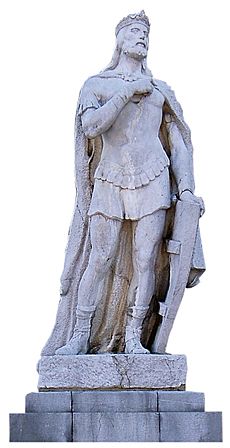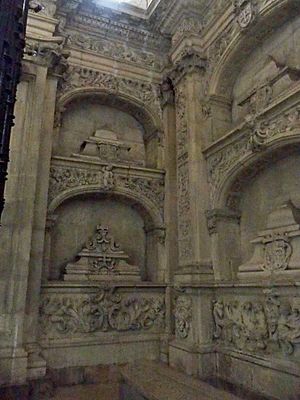Pantheon of Asturian Kings facts for kids
The Pantheon of Asturian Kings is a special chapel inside the Cathedral of San Salvador in Oviedo, Spain. It's a burial place for many kings and queens from the old kingdoms of Asturias and León.
The chapel is named "Our Lady of the Chaste King" because of Alfonso II of Asturias. He was known as "the Chaste" and is thought to have started the cathedral. The first royal burial place was in a 9th-century church on the same spot. This old church and burial area were taken down in the early 1700s because they were in bad shape. Both were rebuilt and opened again in 1712.
Contents
The First Royal Burial Place
In the 800s, Alfonso II of Asturias, who was king of Asturias, ordered a church to be built for the Virgin Mary in his new capital city, Oviedo. He wanted this church to be a final resting place for himself and his wife, Queen Berta. This church later became known as the Church of Our Lady of the Chaste King.
The first royal burial area was located in the front part of the church, called the narthex. Instead of being the main entrance, this area was used only for burying the Asturian kings and queens.
This first burial place was a small, long room. It was about 6 meters (20 feet) wide and 3.6 meters (12 feet) deep, with a height of about 2.4 to 3 meters (8 to 10 feet). The ceiling was made of wood. Above this burial room was the upper choir of the church. On each side of the royal burial place were small rooms, one with stairs leading to the choir. The other room might have been used for storing items for church services.
A wide door connected the burial place to the main part of the church, near the altar. There was also a small window. Both were closed with heavy iron bars, which meant not much sunlight could get in.
This royal burial place looked simple, but it held the bodies of many members of the Asturian-Leonese royal family over several centuries. The tombs were very close together, so it was hard to walk between them. Because there wasn't enough space, some royal family members were buried in other parts of the church. Not all bodies were in tombs or walls; some were buried under the floor, covered by plain stone slabs without names.
Near the stairs to the upper choir, there was a tomb that was highly respected in the 1500s. People believed saints were buried there. However, a historian named Ambrosio de Morales thought the bodies had been moved by then. This tomb was covered with a marble slab. A faded Latin message on it seemed to say "Obtained... Heavenly Kingdoms."
In the royal burial place, near the entrance, about 0.6 meters (2 feet) above the floor, was a tomb with a rough, plain lid. Historians generally agree this was the tomb of Alfonso II, who founded the church and the royal burial place, because of its important location.
Several other members of the Asturian-Leonese royal family were buried elsewhere in the first Church of Our Lady of the Chaste King, outside the main royal burial area:
- Fruela I of Asturias (722-768), king of Asturias.
- Queen Munia de Álava, wife of Fruela I.
- Queen Elvira Menéndez (?-921), wife of Ordoño II of León.
- Queen Urraca Sánchez (?-956), wife of Ramiro II of León.
- Queen Teresa Ansúrez (?-997), wife of Sancho I of León.
Moving the Royal Remains
During a military campaign by Almanzor in 986 against the kingdom of León, King Bermudo II of León wanted to protect the royal remains. He ordered that bodies from León, Astorga, and other places be brought to the Church of Our Lady of the Chaste King in Oviedo. This was to prevent them from being disrespected by the Muslim armies.
These remains were placed in seven wooden boxes and brought to Oviedo. Since there wasn't enough space in the royal burial area, they were placed in the church. The seven boxes held the remains of:
- King Alfonso III of Asturias and his wife Jimena of Asturias.
- Ordoño II of León and his wives Elvira Menéndez and Sancha of Pamplona.
- Ramiro II of León, Sancho I of León, Teresa Ansúrez, Ordoño III of León and Queen Elvira.
- Fruela II of León and his first wife Nunilo Jiménez.
- Queen Elvira.
- Urraca Sánchez, wife of Ramiro II.
- Various princes and princesses.
After Almanzor and his son died, King Alfonso V of León rebuilt the city of León. He moved most of the remains that his father, Bermudo II, had brought to Oviedo back to León. However, the remains of kings Alfonso III and Fruela II, and queens Jimena, Munia, Elvira Menéndez, Urraca Sánchez, and Teresa Ansúrez stayed in the royal burial place in Oviedo.
The New Royal Pantheon
Building the New Chapel
By the late 1600s, the old royal burial place and the Church of Our Lady of the Chaste King were in poor condition. In 1696, Charles II of Spain issued a royal order to use money from certain areas to help maintain and restore the old church. A few years later, in 1705, the cathedral council told the king that the church and royal burial place were still in bad shape. Bishop Tomás Reluz also wrote a letter suggesting the old church be torn down. The king agreed.
Bishop Reluz was the main person who pushed for building the new chapel of Our Lady of the Chaste King in the early 1700s. The new royal burial area was placed between the pillars of the left side of the church, behind an iron gate. Light came in through an oval window. This new location meant the royal burial place was less central, and the church focused more on being a place for the Virgin Mary. However, this placement also allowed for a wider main aisle in the new church.
The agreement to build the new chapel was signed on November 10, 1705, by Bishop Reluz and the builder Bernabé de Hazas. The cost was estimated at 24,000 ducats, and it was expected to take three years. On August 2, 1709, the dome of the new chapel collapsed while it was still being built, causing several deaths. The chapel was finished in 1712. However, the picture of the Virgin Mary was not moved into the new chapel until 1717.
What the New Pantheon Looks Like
The Royal Pantheon is in the last section on the northern side of the chapel of Our Lady of the Chaste King in the Cathedral of Oviedo. It is the most richly decorated part of the cathedral complex. It has many carvings of plants and royal symbols.
Inside, there are six special areas, called niches, where the remains of many Asturian-Leonese royal family members are kept in funeral urns. A plaque on the chapel wall lists the names of those buried there, though it has some mistakes.
The metal gates for the royal pantheon and the church were made by Andrés García Casielles and put in place in 1713. The gate that closes off the Royal Pantheon has the royal symbol of King Philip V of Spain. A similar gate, but without the royal symbol, is in another chapel in the cathedral.
In the middle of the Royal Pantheon is a stone coffin covered by a marble tombstone from the 400s. This is the only tomb that survived from the first royal burial place. Some studies suggest this coffin was used to carry the remains of the Asturian king Alfonso III and his wife Queen Jimena from Astorga to Oviedo. The stone coffin itself is plain. The marble lid is shaped like a coffin, wider at the head than the feet, and covered in carvings. A carved Latin message on it seems to say it holds the body of someone named Ithacius.
INCLVSI TENERVM PRAETIOSO MARMORE CORPVS AETERNAM IN SEDE NOMINIS ITHACII
One way to understand this message is: "I have placed a delicate body with precious marble in the eternal resting place of the family of Ithacius." This tomb was reused in the Royal Pantheon, but it's not clear whose body is inside it now.
Kings and Queens Buried Here
According to historians, the following members of the Asturian-Leonese royal family are buried in the decorated urns of the Pantheon:
- Fruela I of Asturias (722-768), king of Asturias.
- Bermudo I of Asturias (?-797), king of Asturias.
- Alfonso II of Asturias (759-842), king of Asturias.
- Ramiro I of Asturias (790-850), king of Asturias.
- Ordoño I of Asturias (830-866), king of Asturias.
- Alfonso III of Asturias (848-910), king of Asturias.
- García I of León (871-914), king of León.
- Fruela II of León (c.875-925), king of León.
- Queen Munia de Álava, wife of Fruela I.
- Queen Berta, wife of Alfonso II.
- Queen Nuña, wife of Ordoño I.
- Queen Jimena of Asturias (?-912), wife of Alfonso III.
- Queen Elvira Menéndez (?-921), wife of Ordoño II.
- Queen Nunilo Jimena, wife of Fruela II.
- Queen Urraca of Pamplona (?-956), wife of King Ramiro II of León.
- Queen Teresa Ansúrez (?-997), wife of King Sancho I of León.
See also
 In Spanish: Panteón de reyes de la Catedral de Oviedo para niños
In Spanish: Panteón de reyes de la Catedral de Oviedo para niños
- Asturian art
- Catholic Church in Spain




